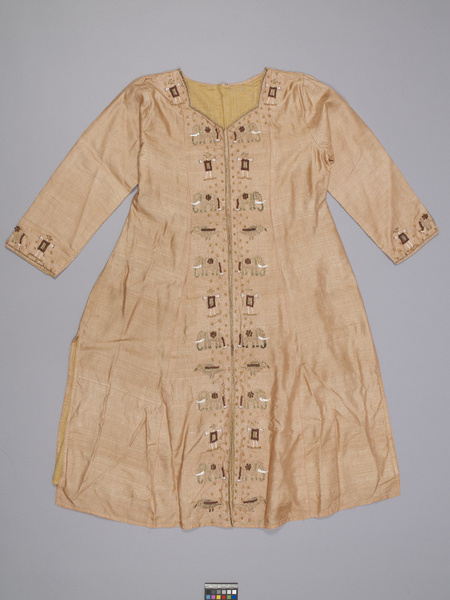Garment Item Number: 3132/2 a from the MOA: University of British Columbia

Description
Long tunic (kameez) worn over pants with a veil, as part of a wedding ensemble (3132/2 b-c). Shirt has long narrow sleeves, a slightly scooped neck, and a front opening that fastens with hooks. Garment is made of wild tussar silk in a light orange-brown colour. It is hand embroidered the length of the front opening on both sides, and around the wrists and front of the neck, along with cording of metallic thread. Images include standing birds, elephants with tusks and long tails, and human figures with arms spread, in gold metallic thread, round wooden beads, and tubular glass and metal beads. The back is undecorated; the interior is lined with panels of silk in a course weave.
Cultural Context
weddings; ceremonial
Specific Techniques
The glass and wooden beads sewn on the outfit were hand-crafted. The raw silk fabric was also hand-woven and hand embroidered. India is the second largest producer of tussar silk, which is produced by tribal groups living in the sub-tropical forested regions.
Narrative
This three-piece raw silk wedding ensemble was commissioned in the 1980s by friends of the bride, Ms. C. Aiyar. Ms. Aiyar, Hindu, came from Tamil Nadu in South India, however the style of this garment is more of a northern style (e.g., salwar/chemise rather than sari), likely because she was marrying a groom from North India. The colour is also unusual, as most Hindu brides prefer to marry in bright red saris. The natural (un-dyed) colour of this material is said to be associated with renunciation and contemplation. It was chosen because the bride had lived with her parents in an ashram until she was 16 years old, when she married.
Item History
- Made in Tamil Nadu, India during 1985
- Owned by Gillian Darling Kovanic and C. Aiyar
- Owned by Rudi Kovanic before September 29, 2015
- Received from Rudi Kovanic (Donor) on September 29, 2015
What
- Name
- Garment
- Identification Number
- 3132/2 a
- Type of Item
- garment
- Material
- silk fibre, glass, wood and metal
- Overall
- height 115.5 cm, width 87.0 cm
Who
- Culture
- South India
- Previous Owner
- Gillian Darling Kovanic, C. Aiyar and Rudi Kovanic
- Received from
- Rudi Kovanic (Donor)
Where
- Holding Institution
- MOA: University of British Columbia
- Made in
- Tamil Nadu, India
When
- Creation Date
- during 1985
- Ownership Date
- before September 29, 2015
- Acquisition Date
- on September 29, 2015
Other
- Item Classes
- textiles
- Condition
- good
- Accession Number
- 3132/0002 a